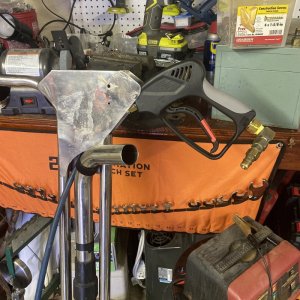14. Animal Stains and Odors
Dogs and cats may be our best friends, but they’re not necessarily the best friends of our carpeting, draperies, and upholstery.
Urine: There are two types of reactions that can take place between the chemicals in an animal's urine and those in the dyes and fibers of textile furnishings. The first type of reaction is immediately noticeable. Some textile dyes change color as soon as urine comes into contact with them.
The other type of reaction develops slowly over several days or months and can result in permanent changes to the dyes and fiber. In many cases, this type of damage can only be seen with the aid of a Black/UV light. Not only can the dye change, but some fibers may become weakened or destroyed by the aged urine. The decomposing urine can also produce an objectionable odor. After cleaning, these areas are more obvious because the soils which hid the changed color and damaged fibers have been removed. Also, dyes weakened by urine can be removed or bleed during professional cleaning.
After cleaning, the area may still glow when observed under UV light. (Actually, the correct term is “fluoresce”—the treated area is reflecting the UV light back to your eyes as visible light.) This fluorescing is not due to the presence of urine in that spot, but from phosphorous left over from the breakdown of phosphocreatine. During that process the phosphorous becomes chemically bonded to the fibers as a dye would. Just like a dye, the phosphorous is now part of the surface of the fibers, and it is quite difficult to remove without damaging the existing dyes on those fibers.
Feces: Pet feces is easier to remove than urine. Compact deposits can be quickly removed with a plastic scraper or spatula. The surface should then be cleaned with the standard spotting solution and blotted dry. Refer to the spotting steps below for further information and techniques. Follow this treatment with a disinfectant recommended by your
IICRC Certified Cleaner or veterinarian.
Loose feces require the same clean-up procedure as described below for fresh urine removal. This should also be followed with an application of disinfectant.
If your pets' food or treats contain red dye to make them look meatier, red discoloration may remain at the site of the accident. Your
IICRC Certified Cleaner may be able to remove this, but with caution as many red food dyes are nearly identical to fabric dyes and some color loss may be unavoidable.
A
IICRC Certified Professional Cleaner will have methods available to minimize the discoloration, disinfect the area, and reduce the smell. It is often impossible to completely restore the original appearance of a textile furnishing that has been damaged with aged pet urine, especially if homeowners attempt to remove the urine using the wrong products or methods. .
Care Tips: Use a wet/dry vacuum for the initial pick up of urine and loose feces and to extract spotting and rinsing agents.
Place a damp white cotton towel over affected areas to keep the accident from drying if the spot cannot be cleaned right away Be aware that some disinfectants and oxy products may cause discoloration of textile furnishings and carpet if not fully rinsed and neutralized.
1. Remove as much solid matter as possible.
2. Blot the area (if still moist from the spill) with a dry absorbent cloth.
3. Blot with a cloth dampened with clear water. Microfiber cloths are ideal for this purpose.
4. If the spot remains, mix a few drops of liquid dish soap with a cup of water in a spray bottle and mist onto the area.
5. Repeat until the spot disappears.
6. Residual discoloration may be removed by applying 3% hydrogen peroxide, and leaving it to work. This may take several hours or a few attempts
7. If you own a home spotting or carpet cleaning machine, rinse the area with clear water only after no evidence of the spot remains.
8. If these procedures do not work, call your
IICRC Certified Professional Cleaner.

